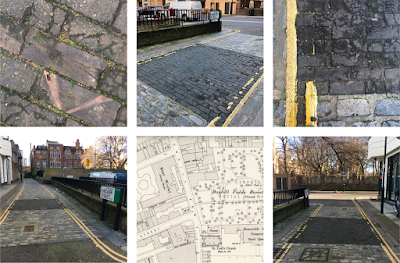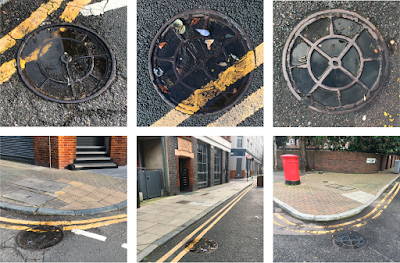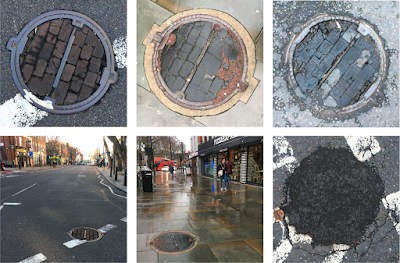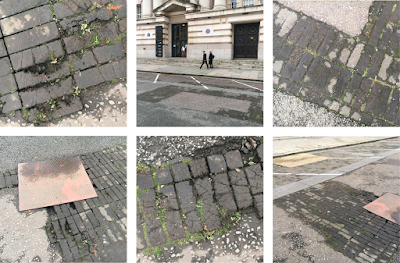A few months back I was involved in an email exchange about the patch of wood blocks adjacent to Bunhill Row Cemetery, just off Artillery Row, specifically, and perhaps coincidentally (ironically?), in Chequer Street. Back in ye olde Victorian times this street ran alongside Star Works, the De La Rue postage stamp manufactory, though I don't know if this company was related to Danny.
 This little road is a patchwork of setts and cobbles and looks to have been repaired, extended or updated with various kinds of blocks – in addition to this patch of wood, there are also granite setts and vitreous setts, the latter being a by-product of the gas industry and said to be identifiable by their bluish glaze. Note also a couple of interesting man hole cover plates.
This little road is a patchwork of setts and cobbles and looks to have been repaired, extended or updated with various kinds of blocks – in addition to this patch of wood, there are also granite setts and vitreous setts, the latter being a by-product of the gas industry and said to be identifiable by their bluish glaze. Note also a couple of interesting man hole cover plates. 
Ah, but this isn't the only patch of wood paving in the metropolis – I have happened upon quite a few other places that show hints of this eco-friendly-but-hard-to-maintain wooden surface. I've found enough to start a specific collection on my desktop and here I am sharing some of them with you...
At 90-92 Pentonville Road N1, on the corner of Penton Street, there is evidence of a whole paved private courtyard that is currently used for car parking. Patches of wood can be seen peeking out from under the receding Tarmac.


Research shows that this was once the display forecourt outside the ground floor showroom of R. W. Wilkins & Son, marble, granite and stone merchants, monumental masons, sculptors, table-top manufacturers, shopfitters, and interior decorators in marble and tiles. This had originally been constructed as three Georgian houses with deep front gardens, mirroring those across the road, and was converted into one premises in the 1860s by Henry Webb Wilkins, probably RWW's father. The rectangular blocks appear to be the same shape and size as the ones at Chequer Street.

Many good remnants of wood block can also be found nestling within the segments of some old manhole covers. Just east of here, near the border of Islington and Hackney (when this was Finsbury and Shoreditch, respectively) there are examples in Mora Street on the southern side of City Road:



In the middle of Grays Inn Road at the junction of Acton Street, there is a superb example, as shown below on the left with the streetscaape below it, and two good ones on Islington High Street – one set within the pavement near Pizza Express, as shown, and another in the road at the rear of the former electricity transformer station and tram depot. A third one, by the southern door to that building, at the corner of Duncan Street, sort of facing The York pub, has been recently covered in Tarmac.

I'd really love to experience the sound of horses walking on a wood-blocked street. The super-informative Roads Were Not Built For Cars shows us that Bartholomew the cartographer, produced road surface maps of London where streets coloured yellow denoted wood, green indicated sheet asphalt, blue was setts, and pink for macadam (a pre-cursor to Tarmac). The rationale that wood blocks offered the benefit of a quieter environment explains their implementation in residental streets such as West Square and in the old hospital zone around City Road.
The same 'quiet' effect would also apply at this next location – the rear of City Hall, on Belvedere Road, built as the London County Council's head offices in 1911 and, hence, a really busy municipal street.

I'm pretty sure I have located more patches across London, but I can't find the pics right now – do let me know if you've found any others yourself.
